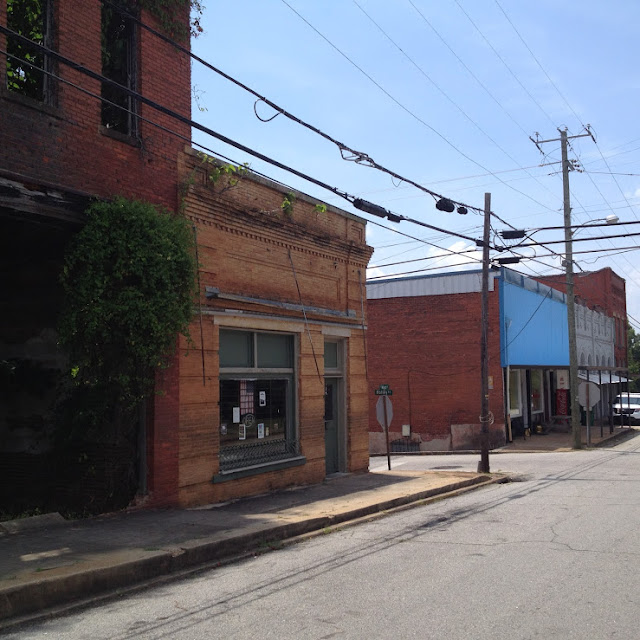This past
July my brother Richard and I made one of our annual trips seeking Alabama and
family history. This time we were in east central Alabama mainly around Brundidge and Camp Hill. We visited several
other places I've already written about such as Smuteye, Union Springs and Aberfoil. I'll be doing a
future post on Tallassee and a second one on Camp Hill. A decade or more ago
mom and two of her sisters, Heth and Marjorie, made a similar trip to Brundidge
and Camp Hill; some things have changed, others not so much.
We visited Camp Hill on a hot Sunday morning. We had already been to Brundidge
the day before, also a very hot late July morning. The heat was about the only
thing in common between the two cities. Brundidge seemed to be a thriving small
town; Camp Hill is a sad and hollow shell of its former vibrant past. Mom says
she and her sisters practically wept at the sight of the town where they had
lived for a few years in the 1930's and remembered so fondly.
In the 2000 U.S. Census the population of Camp Hill was 1,273 people. More
recent estimates in 2014 give the population as 992 or 947.
The Encyclopedia of Alabama has this summary of Camp Hill's history:
"The Camp Hill area began to be settled by the early 1830s just before
Creek Indian Removal. The community initially was referred to as either Burnt
Bull or Ashbank. The name Camp Hill most likely came from the area's popularity
as a camping place.
"Camp Hill remained primarily a farming community throughout the 1850s and
1860s. The Savannah and Memphis Railroad came through in 1870, bringing with it
increased settlement. Camp Hill incorporated in 1895, and its economy at this
time was fueled primarily by cotton gins and a brickyard. In 1898, Universalist
minister Lyman Ward founded the Southern Industrial Institute to educate
underprivileged rural youth. In 1948, it was renamed the Lyman Ward Military
Academy."
The military academy is one of the few thriving institutions left in Camp Hill. Lyman Ward was a fascinating individual; you can learn more about him here. He even ran for governor in 1946 as a
Republican, but was soundly defeated by Democrat Jim Folsom. More information
about the Universalist Church of American is here.
UPDATE 19 April 2021: The Alexander City
Outlook newspaper recently published
an article about a family trying to renew downtown Camp Hill.
UPDATE 9 May 2023: The Alexander City
Outlook newspaper recently published
an article about some Auburn University researchers and their Camp Hill history project.
This cornerstone gives the basic dates.
An historical marker offers more information on just how a Universalist Church ended up in a tiny town in east Alabama in the late nineteenth century.
The church and its grounds are obviously cared for, but a congregation has not met here in many years.
This church is now the Gracefulness Baptist Church. When mom and her family lived in Camp Hill, it was the Methodist Church where my grandfather, John Miller Shores, was minister. He served the North Alabama Conference of the United Methodist Church for some 55 years.
This house was apparently the parsonage for the Methodist Church when mom and family lived there. Mom remembers a large open space between the parsonage and the church. Another house is between this one and the church, but a more modern one. Mom also remembers a large front porch, which seems to fit this house.
Richard spotted the top of this house as seen in the second photograph below. This large structure is well-hidden in an otherwise nice neighborhood. The decay foreshadowed what we saw later in Camp Hill's former downtown.

























































